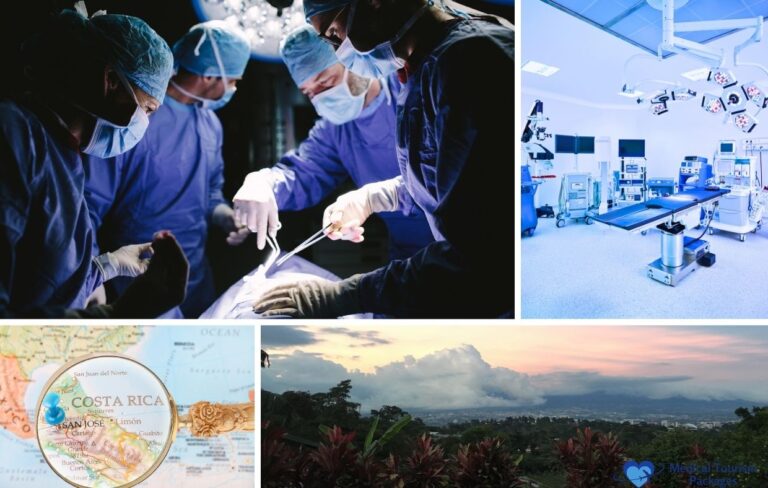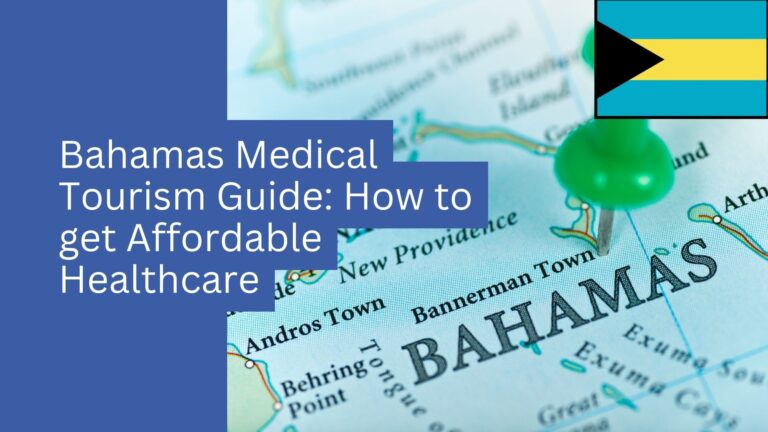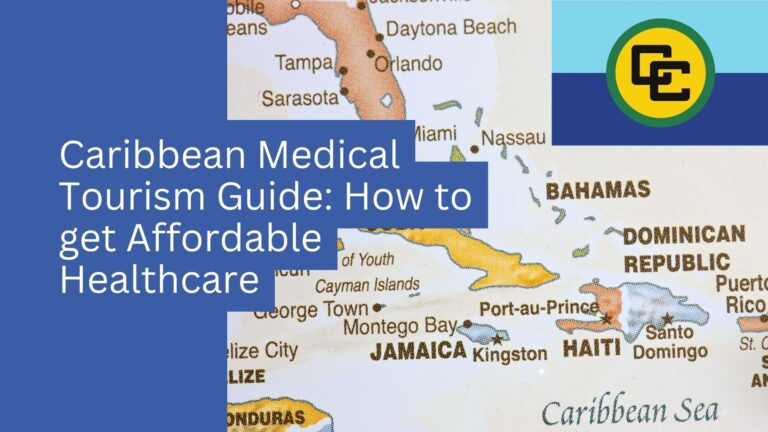Book Appointment Now
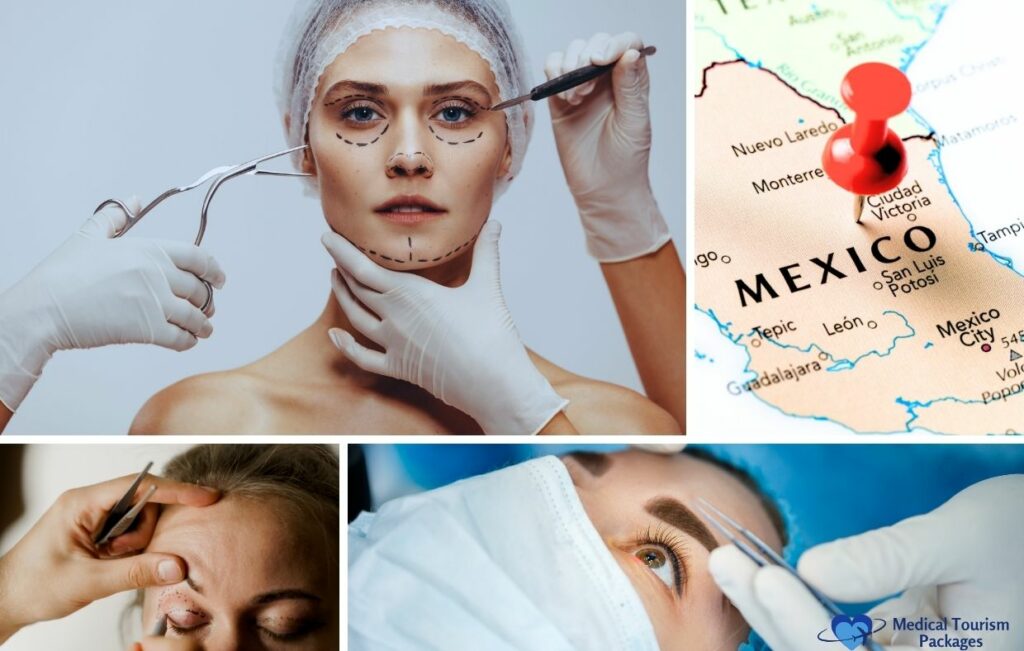
Blepharoplasty in Mexico: Costs, Surgeons & Travel Guide
Mexico has become a leading destination for blepharoplasty, offering eyelid surgery at costs 50-70% lower than United States prices. Board-certified surgeons trained at international institutions perform these procedures in JCI-accredited facilities throughout major cities like Mexico City, Tijuana, Guadalajara, and Cancún. Patients travel to Mexico seeking both upper and lower eyelid rejuvenation to address drooping lids, under-eye bags, and excess skin that creates a tired appearance.
This guide covers everything you need to plan your eyelid surgery journey to Mexico, including pricing ranges, how to verify surgeon credentials through CMCPER certification, surgical techniques, recovery timelines, and travel logistics. When you select accredited facilities and properly certified surgeons, you receive comparable outcomes to North American procedures while saving significantly on costs.
What is Blepharoplasty?
Blepharoplasty is a surgical procedure that rejuvenates the eyelids by removing excess skin, muscle, and fat to address both cosmetic and functional concerns around the eyes. Upper blepharoplasty corrects drooping upper lids that create a hooded appearance or obstruct vision through incisions hidden in the natural eyelid crease. Lower blepharoplasty targets puffy bags, loose skin,put the first link below the first h2, not in the first sentence please and dark circles beneath the eyes using either traditional external incisions or a transconjunctival approach that places incisions inside the lower lid.
The procedure comparison below shows what each type addresses:
| Feature | Upper Eyelid | Lower Eyelid |
|---|---|---|
| Goal | Reduce droopy or hooded upper eyelids to open the eye | Reduce puffiness, under-eye bags, and loose skin |
| Incision Location | Hidden in the natural upper eyelid crease | Inside the lower lid or just under the lash line |
| Concerns Addressed | Excess skin, obstructed vision, sagging lid folds | Fat bulges, dark circles, fine wrinkles, tear trough hollowing |
| Downtime | 7-10 days for swelling and bruising to fade | 10-14 days, as lower lids swell longer |
Why Choose Mexico for Eyelid Surgery?
You should choose Mexico for eyelid surgery because it offers cost savings of 50-70% compared to United States and Canadian prices for blepharoplasty. These lower prices reflect reduced operational costs rather than compromised quality standards, as Mexican plastic surgeons frequently train at prestigious international institutions and many hold dual certifications from Mexico’s CMCPER board and organizations like the American Society of Plastic Surgeons.
English-speaking medical teams make communication seamless for North American patients, while top facilities employ bilingual staff who coordinate every aspect of your care from pre-operative consultations through post-operative follow-ups. State-of-the-art facilities like JCI-accredited Hospital Médica Sur in Mexico City and AAAASF-accredited VIDA Wellness in Tijuana maintain the same equipment and protocols as leading US medical centers, ensuring you receive world-class care at a fraction of the cost.
How Much Does Blepharoplasty Cost in Mexico?
Blepharoplasty costs in Mexico range from $1,200 to $3,500 depending on the procedure type and complexity, representing substantial savings compared to North American and European rates:
| Procedure Type | Mexico Cost | US Cost | Europe Cost |
|---|---|---|---|
| Upper Eyelid Surgery | $1,350 – $3,000 | $3,500 – $4,500 | $2,500 – $4,000 |
| Lower Eyelid Surgery | $1,200 – $3,500 | $3,500 – $5,500 | $3,000 – $4,500 |
| Combined Upper & Lower | $1,750 – $3,500 | $7,500 – $8,000 | $4,000 – $7,000 |
Mexican clinics typically provide all-inclusive pricing that covers surgeon fees, facility costs, anesthesia, and initial follow-up care, which contrasts with US and Canadian facilities that often bill these components separately.
What Factors Affect the Cost?
Several variables influence the final cost of your eyelid surgery in Mexico:
| Factor | Impact on Cost |
|---|---|
| Surgeon’s Expertise | Surgeons with extensive experience and high success rates charge more due to their proven track record |
| Complexity of Surgery | Complex cases requiring advanced techniques or extensive fat repositioning increase procedure cost |
| Facility Accreditation | JCI-accredited hospitals and AAAASF-certified clinics charge higher fees due to stringent safety standards |
| Geographic Location | Major cities like Mexico City command premium pricing compared to smaller metropolitan areas |
| Type of Procedure | Upper eyelid procedures cost less than lower eyelid or combined surgeries due to reduced complexity |
Selecting Your Plastic Surgeon in Mexico
Choosing a qualified surgeon is the most critical decision in your blepharoplasty journey, as your surgeon’s credentials and experience directly impact both safety outcomes and aesthetic results. Mexico has established certification systems that ensure surgeons meet rigorous training standards, but you must confirm your surgeon holds proper credentials from recognized Mexican medical boards before committing to any procedure.
Why is CMCPER Certification Important?
CMCPER (Consejo Mexicano de Cirugía Plástica, Estética y Reconstructiva) is the sole authority that certifies plastic surgeons in Mexico, ensuring practitioners have completed mandatory formal residency and specialty training in plastic surgery. This certification represents at least five years of training following medical school completion and requires surgeons to renew every five years through a rigorous process that maintains competency standards. Many top Mexican specialists also hold active memberships in international organizations like the American Society of Plastic Surgeons (ASPS) and the International Society of Aesthetic Plastic Surgery (ISAPS).
How to Verify Surgeon Credentials
Verify your surgeon’s credentials through official Mexican medical directories before scheduling consultations using these essential steps:
- Professional License (Cédula Profesional) confirms the surgeon completed medical school and holds a valid license to practice medicine in Mexico
- Medical Specialist License (Cédula de Especialidad) verifies completion of plastic surgery residency and specialty training
- Active CMCPER Certification Number ensures current board certification status and that credentials haven’t lapsed or been revoked
- CONACEM Directory Check cross-references through the Consejo Nacional de Certificación en Medicina, which registers certified doctors across all specialties
The official CMCPER website provides a searchable database where you can verify active certification status, and you should request certification numbers directly from your surgeon and verify them independently.
Which Mexican Cities are Best for Blepharoplasty?
Mexico offers several cities with established medical tourism infrastructure for eyelid surgery, each providing distinct advantages based on your priorities:
| City | Key Advantage | Notable Facility | Accreditation |
|---|---|---|---|
| Tijuana | Southern California border access | VIDA Wellness & Beauty | AAAASF |
| Cancún | Vacation setting recovery | Dr. Samano clinic | CMCPER |
| Guadalajara | Medical tourism hub with lower prices | Marroquín & Sandoval | CMCPER |
| Mexico City | Tertiary hospital access | Hospital Médica Sur | JCI |
Your choice depends on geography and medical complexity, as simple blepharoplasty works well in any city while complex revisions may benefit from Mexico City’s hospital resources.
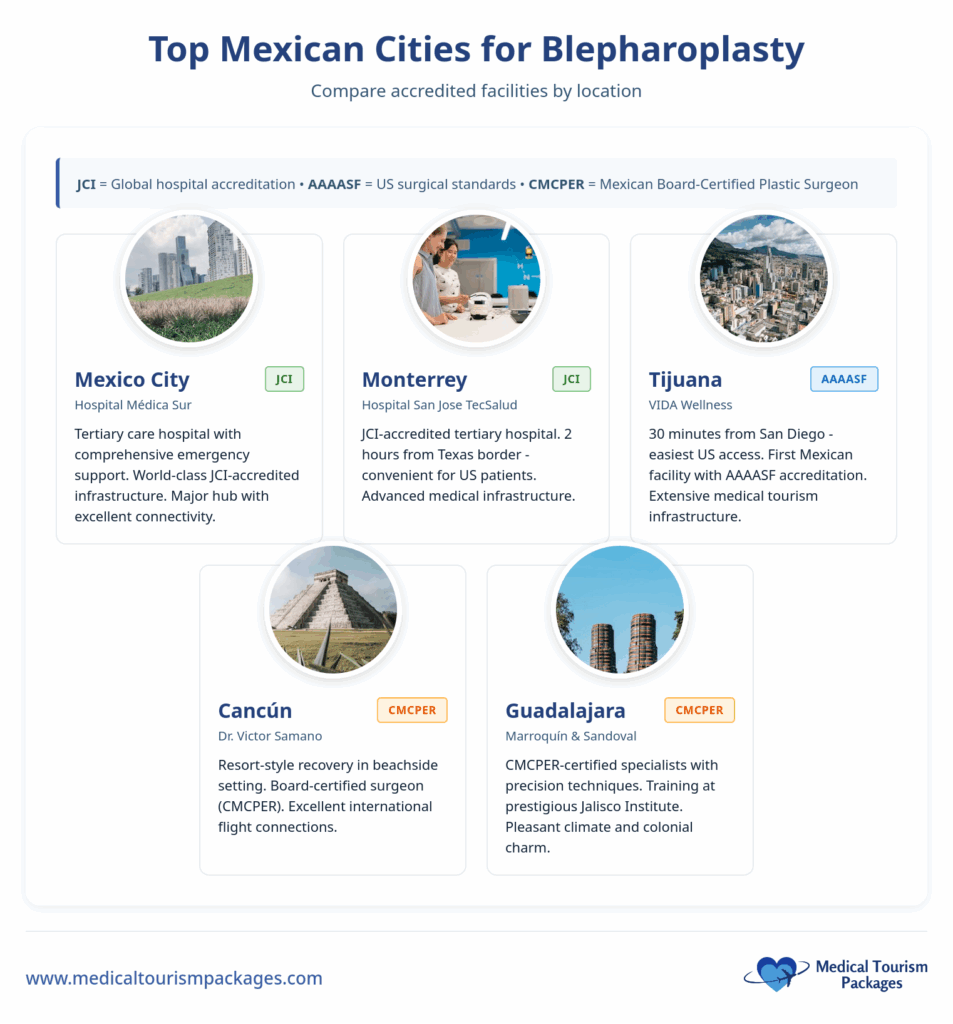
How is Blepharoplasty Performed in Mexico?
Blepharoplasty in Mexico follows international surgical standards as a one to three-hour outpatient procedure where you return to your accommodation the same day. Your surgeon will recommend either local anesthesia with sedation or general anesthesia based on the extent of your surgery.
What Pre-Operative Assessments Are Required?
Your surgeon conducts thorough evaluations before surgery:
- Medical history review examines health conditions, medications, and previous surgeries
- Physical examination assesses eyelid structure, skin quality, and fat distribution
- Vision tests with an ophthalmologist check eye health and visual acuity
- Photographic analysis documents baseline appearance for surgical planning
- Required medical tests include blood work and cardiac evaluation for patients over 40
What Surgical Techniques Are Used in Mexico?
Surgeons in Mexico employ multiple approaches based on your anatomy and goals:
| Technique | Approach | Best For |
|---|---|---|
| Traditional Blepharoplasty | Incisions along natural eyelid creases to remove excess skin and fat | Patients with significant skin laxity |
| Transconjunctival | Access fat through inside of lower eyelid with no external incisions | Younger patients with fat bulging but minimal loose skin |
| Laser-Assisted | Laser technology makes incisions and coagulates blood vessels | Patients wanting reduced bruising and swelling |
| Fat Repositioning | Moves orbital fat rather than removing it to fill hollow areas | Creating smooth transition between eyelid and cheek |
What Are the Surgical Procedure Steps?
The procedure follows a systematic sequence beginning with anesthesia administration where the anesthesiologist monitors your vital signs throughout surgery. The surgeon creates incisions along the natural crease for upper lids or just below the lash line or inside the eyelid for lower lids. Excess fat, skin, and sometimes muscle are removed or repositioned depending on your needs. Fine sutures close the incisions precisely to minimize scarring, with stitches typically dissolving or being removed within one week. You’ll spend one to two hours in a supervised recovery area where nurses monitor your condition before discharge.
What is the Recovery Process?
Recovery from blepharoplasty progresses through predictable stages, with most patients experiencing the most dramatic improvements in the first two weeks while complete healing takes several months:
| Timeline | What to Expect | Care Instructions |
|---|---|---|
| First 48 hours | Maximum swelling and bruising | Apply cold compresses every 2-3 hours |
| 1 week | Suture removal, noticeable reduction in swelling | Keep surgical area clean and dry |
| 2 weeks | Comfortable appearing in public, most swelling subsided | Continue avoiding strenuous activities |
| 1 month | Significant improvement visible | Residual swelling continues diminishing |
| 3-6 months | Final results apparent, scars fade to thin white lines | Incision lines continue to fade |
Plan to stay in Mexico for at least seven to ten days to allow for your suture removal and initial follow-up appointments.

What is Immediate Post-Operative Care?
The first days after surgery require consistent attention to optimize healing:
- Cold compresses applied for 10-15 minutes each hour while awake using clean gauze or soft cloth help reduce swelling
- Pain medication prescribed by your surgeon or over-the-counter pain relievers manage discomfort effectively
- Infection prevention requires keeping the surgical area clean and dry following specific cleaning instructions
- Eye care includes prescribed lubricating drops to prevent dryness and keep eyes comfortable during healing
How Do You Manage Pain and Discomfort?
Your surgeon prescribes specific medications to ensure comfortable recovery:
| Medication Type | Purpose | Usage Notes |
|---|---|---|
| Pain relievers | Control post-operative discomfort | Acetaminophen or prescription analgesics as needed |
| Antibiotics | Prevent infection during healing | Oral antibiotics taken as prescribed |
| Anti-inflammatories | Reduce swelling | Some surgeons avoid NSAIDs due to bleeding risk |
Sleep with your head elevated on two or three pillows for at least one week to minimize swelling and promote fluid drainage. Avoid strenuous activities including heavy lifting, bending over, or vigorous exercise for two to three weeks, as these increase blood pressure in your face. Wear wraparound sunglasses for maximum protection when going outside to shield your eyes from sun, wind, and dust.
What are the Risks and Considerations?
Blepharoplasty is generally safe, but all surgery carries risks that you should understand before proceeding. Common complications include infection, bleeding, anesthesia reactions, asymmetry between eyelids, dry eyes, and vision problems, though serious issues are uncommon.
Understanding complication frequency and management helps you make an informed choice:
| Complication | Frequency | Management Strategy | Long-Term Impact |
|---|---|---|---|
| Infection | 1-2% | Antibiotics, wound care, possible drainage | Minimal if treated promptly |
| Bleeding/Hematoma | 1-3% | Pressure application, possible surgical drainage | Usually resolves completely |
| Asymmetry | 5-10% | Observation period, possible revision surgery | Can be corrected with additional procedure |
| Dry Eyes | 10-15% | Artificial tears, eye drops, temporary punctal plugs | Usually resolves in 3-6 months |
| Vision Problems | \<1% | Immediate medical evaluation, specialist referral | Most resolve; rarely permanent |
What Are Common Complications for Blepharoplasty?
While blepharoplasty is generally safe, understanding potential complications helps you recognize warning signs and respond appropriately. Temporary vision disturbances including blurred vision or double vision can occur immediately after surgery due to swelling and ointment application, typically resolving within days. Swelling and bruising represent the most common side effects, peaking within 48 hours and gradually diminishing over two weeks with proper cold compress application and head elevation.
Persistent dry eyes affect 10-15% of patients as surgery temporarily disrupts tear film distribution, requiring artificial tears and lubricating drops for several weeks to months until normal tear function returns. Light sensitivity often accompanies dry eyes during the first few weeks, making sunglasses essential for outdoor activities and bright environments. Infection and bleeding risks remain low at 1-3% when you follow post-operative care instructions precisely, including keeping the surgical area clean and avoiding activities that raise blood pressure.
Asymmetry between eyelids can result from natural healing variations or pre-existing facial asymmetry becoming more apparent after surgery, with most cases improving over three to six months as swelling fully resolves. If asymmetry persists beyond this period, minor revision procedures can correct the imbalance. Contact your surgeon immediately if you experience severe pain, sudden vision loss, excessive bleeding, signs of infection like fever or pus, or any symptoms that concern you.
What Factors Affect Surgery Success?
Surgeon experience matters most, as a specialist who performs many blepharoplasty procedures understands eyelid anatomy deeply and can handle complications while adjusting techniques for your specific needs. Your overall health and skin condition influence outcomes significantly, with good health promoting faster healing while pre-existing conditions like thyroid problems require special management. Following pre-operative and post-operative care instructions determines your result quality through proper medication use, wound care, and attending all follow-up appointments. Maintaining realistic expectations protects your satisfaction, as blepharoplasty improves eyelid appearance but doesn’t stop aging or change your basic eye shape.
What Results Can You Expect?
Blepharoplasty delivers noticeable rejuvenation to your eye area by removing the tired appearance that droopy lids and puffy bags create. The surgery addresses sagging upper eyelids that hood over your eyes and eliminates or reduces under-eye bags, opening up your eye area so your eyes appear larger and brighter.
Expected timeline for visible improvements:
| Timeframe | Result Visibility |
|---|---|
| 2 weeks | Initial results apparent, swelling decreased, bruising faded |
| 1-3 months | Final results emerge as subtle swelling resolves, scars fade |
| 7-10 years | Results typically endure this long or longer |
| Beyond | Aging continues naturally, gravity and time will eventually affect eyelids again |
Patient satisfaction rates run high for this procedure, with studies showing 85-95% of patients report being pleased with their outcomes.
Who Are Ideal Candidates for Blepharoplasty?
Good candidates for blepharoplasty are people in generally good health who want a refreshed appearance around their eyes with realistic expectations. Ideal candidates have drooping upper eyelids or puffy lower lids that make them look tired, are bothered by excess skin that interferes with vision or appearance, and are nonsmokers or willing to quit at least four weeks before surgery. You should be emotionally stable and pursuing surgery for personal goals while understanding that surgery improves but doesn’t perfect eyelids.
What Are the Contraindications for Blepharoplasty?
Certain medical conditions make blepharoplasty unsafe or inadvisable. Uncontrolled high blood pressure creates excessive bleeding risk during surgery that must be managed before proceeding. Active eye conditions including dry eye syndrome, glaucoma, infections, or inflammations require resolution first to prevent complications. Systemic illnesses such as uncontrolled diabetes, autoimmune disorders, bleeding disorders, or thyroid problems need medical clearance and stabilization. Unrealistic expectations that surgery will transform your life or make you look like someone else indicate you’re not ready for this procedure.
How Do You Prepare for Surgery?
Proper preparation ensures your safety and improves your surgical outcome through specific steps in the weeks before your procedure. Your surgeon will conduct a medical evaluation to confirm you’re healthy enough for surgery by reviewing your complete medical history and examining your eyes and eyelids carefully.
What Medical Tests Are Required?
Your surgeon will order specific tests to check your overall health status:
- Blood tests including complete blood count and coagulation studies
- Cardiac tests such as electrocardiogram (ECG) if you have a history of heart problems
- Imaging studies and photos to document your starting appearance
What Lifestyle Adjustments Are Necessary?
Make these important changes before your procedure:
- Quit smoking completely at least four weeks before surgery, including all tobacco and nicotine products
- Abstain from alcohol for one week before your procedure
- Avoid bleeding-risk medications by stopping aspirin, ibuprofen, and other NSAIDs two weeks prior
- Focus on healthy eating with protein-rich foods, fruits, vegetables, and reduced salt intake
- Stay well hydrated by drinking adequate water until the prescribed fasting time
What Are the Pre-Operative Instructions?
Follow these specific instructions before your procedure:
- Fast for eight hours before your procedure time with no food or liquids after midnight for morning surgery
- Cleanse your face thoroughly the night before and morning of surgery
- Remove all makeup completely including eye makeup, cosmetics, nail polish, and contact lenses
- Arrange your recovery space with extra pillows, ice packs, medications, and easy-to-eat foods within reach
How Do You Travel to Mexico for Surgery?
Medical tourism to Mexico requires careful planning through several essential steps. Research and select a clinic by looking for board-certified plastic surgeons with extensive blepharoplasty experience, reading patient reviews, and verifying credentials through official medical boards. Schedule a consultation before committing to surgery, as many Mexican clinics offer virtual consultations via video call. Book your surgery once you’ve chosen your surgeon, with clinics typically requiring a deposit to secure your date. Arrange travel and accommodation well in advance by booking flights with flexible change policies and choosing lodging close to your clinic.
When to Fly In and Out
Arrive at least one to two days before your surgery date to adjust to the time zone and complete final pre-operative appointments. Your pre-operative appointment usually happens the day before surgery when the surgeon performs a final examination.
Depart eight to ten days after surgery at the earliest, and only after your surgeon clears you in writing. Wait for suture removal before flying, as upper lid sutures typically come out at five to seven days. Air travel increases swelling due to cabin pressure changes, so flying too early can compromise your results and raise the risk of complications. Plan for the possibility of staying longer by purchasing travel insurance that covers trip extensions.
What Accreditations Should Facilities Have?
Accreditations prove that a medical facility meets rigorous safety and quality standards and serves as your assurance that the clinic maintains international protocols for patient care. JCI accreditation represents the global pinnacle of healthcare quality through Joint Commission International standards, which evaluate comprehensive safety systems, infection control, medication management, and patient rights. Hospital Médica Sur in Mexico City and Hospital San Jose TecSalud both hold JCI accreditation, demonstrating their commitment to tertiary-level hospital care.
AAAASF accreditation applies United States standards specifically to operating rooms and ambulatory surgery facilities through the American Association for Accreditation of Ambulatory Surgery Facilities. VIDA Wellness in Tijuana became the first Mexican facility to earn AAAASF accreditation, meeting the same surgical facility standards required in the United States. Look for these accreditations when choosing your surgical facility, as they indicate serious commitment to patient safety and willingness to submit to external auditing processes.
Frequently Asked Questions About Blepharoplasty in Mexico
Is blepharoplasty in Mexico safe?
Yes—when you choose CMCPER-certified surgeons operating in JCI or AAAASF-accredited facilities. Mexican board certification mirrors U.S. standards, typically requiring 5+ years of plastic surgery residency. Verify credentials in official CMCPER databases, confirm facility accreditation independently, and review multi-source patient feedback. Top centers follow strict infection control, use modern equipment, and maintain robust emergency capabilities comparable to North American hospitals.
Is blepharoplasty painful?
Most patients report mild discomfort—tightness or burning—rather than severe pain. You won’t feel pain during surgery due to local anesthesia with sedation or general anesthesia. Post-op discomfort peaks in the first 48 hours and responds to prescribed meds or acetaminophen, with most patients switching to over-the-counter options by day 3–4.
Can I combine blepharoplasty with other procedures?
Yes. Common pairings include brow lift, facelift, and peri-ocular laser resurfacing. Combining can reduce anesthesia and facility costs and consolidate recovery into one period, though total surgery time increases and recovery may be slightly longer than a standalone eyelid procedure.
When can I wear makeup after blepharoplasty?
Eye makeup typically resumes at 2–3 weeks once your surgeon confirms incision healing. Avoid makeup during week 1. After suture removal at 7–10 days, you may use makeup away from incision lines if cleared. Start with new, hygienic products; choose mineral or hypoallergenic formulas; and remove gently with oil-free cleansers.
Is blepharoplasty covered by insurance?
Cosmetic blepharoplasty isn’t covered. Upper eyelid surgery may be covered when it treats functional visual obstruction, usually requiring ophthalmologic documentation of significant field loss (often ~30% or more). Insurers may ask you to try non-surgical measures first and may cover only the functional portion. Lower blepharoplasty is cosmetic and not covered.
How long do blepharoplasty results last?
Results typically last 7–10 years or longer. Longevity depends on age, skin quality, genetics, sun exposure, and smoking. Upper eyelid results are often more long-lasting since removed skin doesn’t return; lower lids may need touch-ups sooner due to ongoing changes in fat and skin. Many patients treated in their 40s–50s don’t need revision for a decade or more.
How long does blepharoplasty surgery take?
Total time is usually 1–3 hours: upper lids about 45–60 minutes per eye; lower lids 1–2 hours; combined upper and lower about 2–3 hours. Complex cases (fat repositioning, muscle tightening, revision) may approach 3 hours. Expect an additional 1–2 hours for pre-op preparation and post-op monitoring before discharge.
How soon can I return to work?
Most people return in 7–10 days. Desk or remote work is often feasible around day 7 once swelling and bruising improve. Physically demanding jobs typically require about 2 weeks. If appearance is critical (sales, hospitality, media), consider 10–14 days so bruising resolves and makeup can conceal any residual discoloration.
When can I exercise after blepharoplasty?
Walk lightly right away to promote circulation, but keep your heart rate low during week 1. Avoid strenuous exercise, bending, and lifting >10 lbs for the first 2 weeks. At 2 weeks, add light cardio if cleared by your surgeon. Resume full workouts—including weights, high-intensity cardio, swimming, and contact sports—around 4–6 weeks after complete healing.
What’s the difference between upper and lower blepharoplasty?
Upper blepharoplasty removes excess skin and fat that cause hooding or obstruct vision, with incisions hidden in the eyelid crease. Lower blepharoplasty treats under-eye bags and loose skin via a sub-lash external incision or an internal (transconjunctival) approach. Upper lids usually recover faster; lower lids swell and bruise more. Many people need only upper lids in their 40s–50s, while lower-lid issues may appear later or be addressed with fat-repositioning techniques.
What is transconjunctival blepharoplasty?
A “scarless” lower-lid technique using an incision inside the eyelid to remove or reposition fat, leaving no external scar. It suits patients with puffy fat pads and good skin elasticity, but minimal excess skin. Recovery is often faster with less bruising since external skin isn’t disturbed. Significant loose skin still requires an external lower-lid approach or adjunctive resurfacing.
Is Blepharoplasty in Mexico Right for You?
Blepharoplasty in Mexico delivers world-class results at 50-70% savings compared to US costs when you choose CMCPER-certified surgeons and JCI-accredited facilities. Success requires verifying credentials through official channels, committing to the 8-10 day recovery period in Mexico, and maintaining realistic expectations about outcomes.
Medical Tourism Packages connects you with verified plastic surgeons and accredited facilities while coordinating every detail of your journey. Our all-inclusive packages handle surgeon selection, travel arrangements, accommodations, and post-operative care to ensure safe, seamless eyelid rejuvenation.
Ready to transform your appearance? Contact us today for your free consultation and personalized cost estimate. Our medical tourism coordinators will match you with the right surgeon, facility, and package for your needs and budget.

